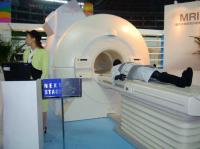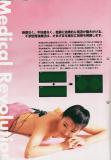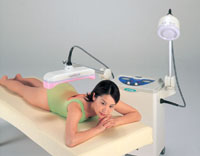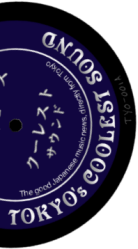Blog - denki biribiri
 denki biribiri
denki biribiri
For about a month my left leg has been hurting a bit after hours spent sitting at work. The pain seems to be centered in my knee, but propagates up and down my leg.
 Since this doesn't seem to be going away, this morning I went to a clinic where they deal with that type of stuff. They took X-rays and verified that there's nothing abnormal with my bones, and the doctor said it may be some problem in the bottom of my spine, though that can only be verified with MRI (magnetic resonance imaging) which may be done next time in about a week.
Since this doesn't seem to be going away, this morning I went to a clinic where they deal with that type of stuff. They took X-rays and verified that there's nothing abnormal with my bones, and the doctor said it may be some problem in the bottom of my spine, though that can only be verified with MRI (magnetic resonance imaging) which may be done next time in about a week.
Meanwhile, I'm getting some physiotherapy, or "rehabilitation" (scary word which to me evokes someone relearning to walk after an operation or accident, but really has a wider meaning than that) as they refer to it, to see if it gets any better, and to at least appease the pain. The treatments I had this morning were interferential current (IFC, in Japanese 干渉波) therapy and microwave heat therapy, 10 minutes each.
 IFC therapy consists of applying low electrical current of different frequencies near painful regions, done by placing electrodes on the skin. "Where these waves intersect below the surface of the skin, the low-frequency stimulation induces the body to secrete endorphins, which are the body's natural pain-killers." (ref.)
IFC therapy consists of applying low electrical current of different frequencies near painful regions, done by placing electrodes on the skin. "Where these waves intersect below the surface of the skin, the low-frequency stimulation induces the body to secrete endorphins, which are the body's natural pain-killers." (ref.)When explaining it, the nurse described the sensation as "denki biribiri", an electric tingling (or a good Denki Groove track).
 Microwave heat therapy is done by placing large microwave heated "applicators" at proximity of the body. "With a good penetration of the fatty tissue especially the underlying muscular tissue becomes heated. On the other hand there is an additional warming up of the skin and therefore an improvement of the blood flow of deeper lying organs via the cutisvizeral reflex paths." (ref.)
Microwave heat therapy is done by placing large microwave heated "applicators" at proximity of the body. "With a good penetration of the fatty tissue especially the underlying muscular tissue becomes heated. On the other hand there is an additional warming up of the skin and therefore an improvement of the blood flow of deeper lying organs via the cutisvizeral reflex paths." (ref.)
Being in a room containing about 8 of the machines used for this therapy, all in use, most by elderly patients, I noticed that it must require some imagination to place the machine's two arms adequately for a patient's specific needs.
Also, I was surprised to realize that "microwave" translates in Japanese to マイクロ波, of which the "波" kanji literally means "wave" but to me always only ever evoked water waves because of its 水 (water) radical. So now I know that it's also used for microwaves and sinewaves (サイン波).
In Japanese, the word for "microwave" isn't used as commonly as in English, because the microwave oven is commonly called 電子レンジ ("electric oven").
I hope this pain will go away quickly and easily. It's not that it's very painful, but it is to a point where it's at least annoying and I don't want it to last forever.
Maybe I'll go back there on Saturday for more biribiri action. A nurse told me that some elderly people go there as often as everyday!
Photo sources: MRI, IFC, microwave.
Posted on June 16, 2005 at 14:01 | Tweet
|
Trackback
- chipple.net
MRI
You might remember that I had leg problems about 2 years ago. After some months it had got better. But...
May 12, 2007 at 19:39
Comments RSS
I had IFC therapy done on my shoulder earlier this year and it got better quite quickly. The principle is the same as Reiki, I guess.
You might also want to visit
http://www.tokyophysio.com for a second opinion.
Posted by Roy on June 16, 2005 at 14:34
Good to hear I'm not the only one aside ojiichan and obaachan. :)
I'll definitely seek second opinion if they suggest anything radical, but hopefully IFC and that type of stuff can take care of it.
Posted by Patrick on June 16, 2005 at 14:44
Funny how you manage to turn a such a serious topic into an interesting read about music and Japanese language :)
Hope you leg feels better soon!
Posted by Erik on June 18, 2005 at 16:40
Thanks. :)
Went for another session this morning, not so much change so far maybe, but the worse times are at work so I'll see next week.
Posted by Patrick on June 18, 2005 at 19:05



